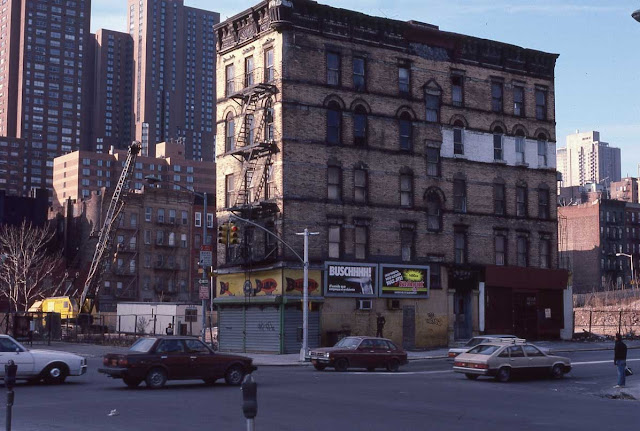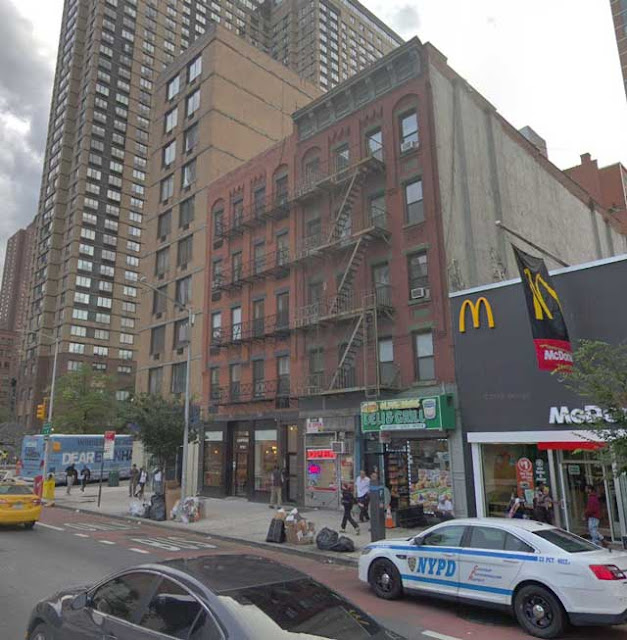96th Street and Second Avenue, Manhattan
 |
| Second Avenue at 96th Street, southwest corner, New York, in 1985. |
One of the biggest changes in New York City over the past few decades has been the changing character of certain neighborhoods. The area of Manhattan is on the fringes of the neighborhood known as Yorkville, with its southern boundary at East 79th Street and its northern at East 96th Street. This is a good example of a neighborhood that has seen a lot of development during that time. The above photograph from 1985 was a bit difficult to place at first because the area has changed so much, but I finally pinpointed the location. So, here we will do a comparison of East 96th Street at Second Avenue from 1985 to 2018.
This post is also an example of how confusing it can be to identify a site from an old photo!
 |
| Southwest corner of 96th at Second Avenue in June 2022 (Google Street View). |
Above is the same corner as in the 1985 photo. Normandie Court Apartments III was built in 1986 during a frenzy of construction throughout Manhattan due to some tax credits. The current building extends from 225 East 95th Street, to East 96th Street. In the 1985 photo, you can see where they were clearing the construction zone for the Normandie Court building, apparently they just had not yet gotten to the final building on the corner. Perhaps the owner was a holdout - being the last building left on the site of a major construction project could mean major dollars, with the condition of the soon-to-be-torn-down building itself being irrelevant. There's probably an interesting background story there we'll never know.
I think we can all agree that the neighborhood looks a lot more updated now!
For orientation, the tall building you can see to the left in the background of both photos is (I believe) Ruppert House, 222 East 93rd Street, New York, NY (trying to line up the same angle is tricky, but I think that is the one). The building to the left (looking south) of 222, namely 245 East 93rd or Astor Terrace, was not built until 1986 (yes, that year comes up over and over in Manhattan real estate), so it obviously could not have been in the 1985 photo.
The 42-story Ruppert House Yorkville apartment building with 650 residential units was built in 1973, so was already a veteran in the 1985 photo, though it was renovated in 2004 and thus may not look exactly as it did (looks pretty similar to me, though). You can see how, back in the 1970s and 1980s, that building on 93rd Street was on "the fringes" of the Upper East Side, and more so the new Normandie Court building on 96th Street - now, not so much, the whole areas has been gentrified.
Below, for comparison, is the opposite - northwest - corner of the same intersection recently, just to show how the neighborhood has changed. I originally thought that was the same view as in the top 1985 photo, but as a helpful commenter noted, I was mistaken and looking the wrong way. But now, having done a bit more research myself, it all makes sense and everything lines up. I actually remember being a bit confused about how things lined up originally because there were some incongruities, but now we have it right, I believe.
 |
| Google Street View of East 96th Street and Second Avenue, northwest corner, NYC (Google Street View). |
In the original photo, we are looking at the southwest corner of Second Avenue at 96th Street. The building shown is on the fringes of East Harlem since it is on the dividing line of 96th Street. That may mean a great deal to real estate agents, but living right on the fringe of another neighborhood, with views of that area, these days really makes it a minimal distinction to make these days as everything is gentrified (it may have meant something entirely different, say, in 1950). It also is fair to say that the area looks a lot cleaner and ship-shape now, less grungy and more orderly. That is what gentrification will do for you.
All this just shows you how important a few blocks could mean in Manhattan, given the massive changes just south of there. This is a pretty good illustration of the slow march north of what we consider the Upper East Side, which now pretty much just continues with much the same character up to Harlem.
 |
| Looking south toward the same location at the corner of 96th Street and Second Avenue, NYC (Google Street View). |
As a bonus, below is a NYC Transit Department aerial photo of the northwest corner of 96th and Second Avenue from when they were doing work on the 2nd Avenue Subway ca. 2012. It shows the McDonald's, etc.
 |
| 96th Street at Second Avenue, northwest corner, ca. 2012, courtesy of Flatiron Construction Corp. |
Overall, most people would probably say that the changes in the intervening three decades are for the better. There are now trees, the rundown buildings have been revitalized, and there are popular businesses such as McDonald's where previously there was nothing but dirt and concrete. However, all gentrification comes at a cost, and there undoubtedly are people who used to live in the area who were forced out by rising rents and the march of progress. Not everybody is going to agree that change is good, no matter how much more modern it may look. However, there is a pretty striking contrast between then and now on this particular corner. That's how a big city evolves, and now lots of affluent workers, retirees, and others have revolutionized a previously decaying area.
Anyway, I hope you enjoyed this entry in my "the more things change, the more they stay the same" series. Please visit some of my other pages where I examine the evolution of cities over time.
2023
No comments:
Post a Comment
Note: Only a member of this blog may post a comment.